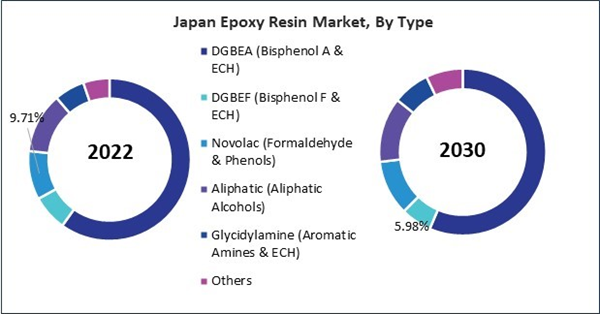Liquid epoxy resins are fundamental components of the market, offering a versatile and widely utilized solution for a diverse array of applications across industries. As a key segment of the market, liquid formulations provide manufacturers with flexibility in processing and application, allowing for easy handling, mixing, and customization to meet specific performance requirements. Therefore, the China market utilized 183.74 kilo tonnes of Liquid epoxy resins in 2022.
The China market dominated the Asia Pacific Epoxy Resin Market by Country in 2022, and would continue to be a dominant market till 2030; thereby, achieving a market value of $1,941.8 million by 2030. The Japan market is experiencing a CAGR of 5.8% during (2023 - 2030). Additionally, The India market would exhibit a CAGR of 7.1% during (2023 - 2030).
It is widely used as a matrix material in composite structures for aircraft components, including wings, fuselages, empennage, and interior panels. Epoxy-based composites offer a high strength-to-weight ratio, durability, and fatigue resistance, making them ideal for aerospace applications where weight reduction and performance are critical. Epoxy adhesives and sealants are utilized for bonding and sealing aerospace components, such as aircraft frames, engine components, and interior fittings. Epoxy adhesives provide strong bonds, excellent adhesion to various substrates, and resistance to harsh environmental conditions, enhancing structural integrity and reliability.
One of the primary drivers behind adopting epoxy resin is its exceptional performance characteristics. Epoxy resins offer a unique combination of high strength, durability, chemical resistance, and adhesion properties, making them well-suited for various applications. Industries such as aerospace, automotive, construction, electronics, marine, and consumer goods leverage these properties to enhance product performance, reliability, and longevity. For example, according to Invest India, the construction sector will grow to $1.4 trillion by 2025.
China’s healthcare sector is experiencing rapid growth, fueled by increasing healthcare spending, expanding access to medical services, and growing demand for advanced medical devices. Adopting Epoxy resin-based materials in surgical devices and implants promotes epoxy resin expansion in the medical device industry, driven by the increasing demand in China's healthcare system for minimally invasive operations, orthopedic treatments, and cardiovascular procedures. As per the National Medical Product Administration, China published a development plan for the medical equipment industry in December 2021 for the 14th Five-Year Plan period (2021-2025) to improve public health. According to the strategy, the nation wants to hasten the adoption of information technology in the medical equipment sector by 2025, resulting in the development of medical robots and digital health platforms. Therefore, due to the above-mentioned factors, the market will grow significantly in this region.
Based on Form, the market is segmented into Liquid, and Solid. Based on Application, the market is segmented into Paints & Coatings, Adhesives & Sealants, Composites, Electronic Encapsulation, and Others. Based on Type, the market is segmented into DGBEA (Bisphenol A & ECH), DGBEF (Bisphenol F & ECH), Novolac (Formaldehyde & Phenols), Aliphatic (Aliphatic Alcohols), Glycidylamine (Aromatic Amines & ECH), and Others. Based on End-use, the market is segmented into Building & Construction, Transportation, General Industrial, Consumer Goods, Wind Energy, Aerospace, Marine & Others. Based on countries, the market is segmented into China, Japan, India, South Korea, Singapore, Malaysia, and Rest of Asia Pacific.
List of Key Companies Profiled
- Atul Ltd.
- BASF SE
- Huntsman Corporation
- Nan Ya Plastics Corp. (NPC)
- Solvay SA
- The Dow Chemical Company
- Olin Corporation
- Mitsubishi Chemical Holdings Corporation
- DIC Corporation
- Hexion Inc. (Hexion Intermediate Holding 2, Inc.)
Market Report Segmentation
By Form (Volume, Kilo Tonnes, USD Billion, 2019-2030)- Liquid
- Solid
- Paints & Coatings
- Adhesives & Sealants
- Composites
- Electronic Encapsulation
- Others
- DGBEA (Bisphenol A & ECH)
- DGBEF (Bisphenol F & ECH)
- Novolac (Formaldehyde & Phenols)
- Aliphatic (Aliphatic Alcohols)
- Glycidylamine (Aromatic Amines & ECH)
- Others
- Building & Construction
- Transportation
- General Industrial
- Consumer Goods
- Wind Energy
- Aerospace
- Marine & Others
- China
- Japan
- India
- South Korea
- Singapore
- Malaysia
- Rest of Asia Pacific
Table of Contents
Companies Mentioned
- Atul Ltd.
- BASF SE
- Huntsman Corporation
- Nan Ya Plastics Corp. (NPC)
- Solvay SA
- The Dow Chemical Company
- Olin Corporation
- Mitsubishi Chemical Holdings Corporation
- DIC Corporation
- Hexion Inc. (Hexion Intermediate Holding 2, Inc.)
Methodology

LOADING...









